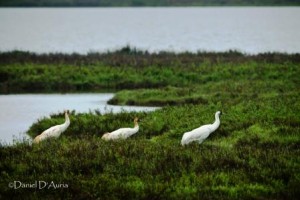by Ron Outen, Regional Director, The Aransas Project
The U.S. Fish and Wildlife Service will hold a second Public Meeting at Aransas National Wildlife Refuge on Wednesday, October 24th. The public is urged to attend to learn about the Service’s new method to count whooping cranes.
It was truly gratifying to see the great outpouring of support for and interest in the whooping cranes from the Rockport community at the October 4th presentation by USFWS on the new distance sampling methodology being used at Aransas National Wildlife Refuge. The questions asked by the audience demonstrated again that the Aransas-Rockport area is one of the most knowledgeable and engaged communities anywhere, especially when it comes to the whooping crane.
We hope that folks who attended that first public presentation, as well as others who may have been unable to attend, will attend a second public presentation being offered by USFWS: 
Wednesday, October 24, 2012
6 to 8 p.m.
Aransas National Wildlife Refuge
(six miles south of Austwell on Farm-to-Market Road 2040)
Because USFWS issued its Aransas-Wood Buffalo Whooping Crane Abundance Survey (2011 – 2012) only one day before the October 4 briefing, this is a great opportunity to ask further questions of Aransas Refuge staff after having had more opportunity to review the report, or simply to ask questions that you didn’t get a chance to ask last time.
Video of October 4th presentation Available Online:
The Aransas Project has posted a video documenting the two-hour public presentation by the U.S. Fish and Wildlife Service on the distance sampling methodology in use at the Aransas National Wildlife Refuge during the last wintering season. The presentation was held on Oct. 4, 2012 in Fulton, and includes the formal presentation as well as questions from the audience following the presentation. While there was a great crowd on hand with many well-informed questions, we know that many people were not able to attend. We hope that this video documentation is helpful to the whooping crane community around the world in staying informed on this critical issue.
As you can see in the next article below, the defendants in TAP’s litigation have sought to supplement the record with USFWS’ Oct. 3 report, which is critical of Stehn’s methodology. We think that you will find that the tone of the presentation captured in the video differs significantly in its characterization of Stehn’s work from that of the written report released by USFWS one day prior to that public meeting. It also gives you a great sense of the strong level of public engagement on this issue.
Defendants Seek to File USFWS Report in TAP Litigation:
Judge Will Not Admit Without Full Evidentiary Hearing to Probe Credibility
As reported recently by Matthew Tresaugue of the Houston Chronicle, TAP supporters should also be aware that the State of Texas, the Guadalupe-Blanco River Authority and other defendants have sought to introduce USFWS’ Oct. 3 report into evidence more than 9 months after the close of the trial in TAP’s lawsuit under the Endangered Species Act. The Oct. 3 report criticizes the previous census method and introduces USFWS’ new statistical modeling method of estimating peak flock size. The previous census method was used since 1982 by USFWS’s own prior Crane Coordinator, Tom Stehn. Stehn’s work led the recovery and survey of this species until he retired in September 2011.
The federal district judge presiding over the case has indicated that the report will not be admitted into evidence without a full evidentiary hearing at which the authors of the report from USFWS are available would be required to testify. Read more about this development.
Crane Migration Back to Texas Coast Underway:
All of us who love the cranes are excited that the annual migration back to the Texas coast from the summer nesting grounds in Canada is underway. In a blog post entitled, “Whooping Cranes Migrating South to Texas” https://whoopingcrane.com/whooping-cranes-migrating-south-to-texas/ , Chester McConnell of the The Whooping Crane Conservation Association reports that the cranes had a successful summer nesting season. Check out Chester’s post to learn more about estimates on the number of cranes expected to arrive at the Refuge.
The Victoria Advocate Editorial Board also issued an editorial on the return of the cranes, encouraging residents to visit the Refuge to see the cranes and noting significantly that:
In a way, the cranes are protecting us as well. Their protected status limits the amount of water that can be taken from the rivers feeding into the refuge in order to maintain the correct balance in the estuary that houses the cranes’ major food source. While this may be an inconvenience for some area industries, it ultimately protects our waters from being siphoned away from our area, keeping it here to meet the needs of area residents and wildlife.
While all of us in the Coastal Bend need no reminder of the critical link between our well-being and that of the cranes, it is encouraging to see this message from the Advocate’s Editorial Board.
Thanks so much for your continued support. Please feel free to forward this on to a friend.

